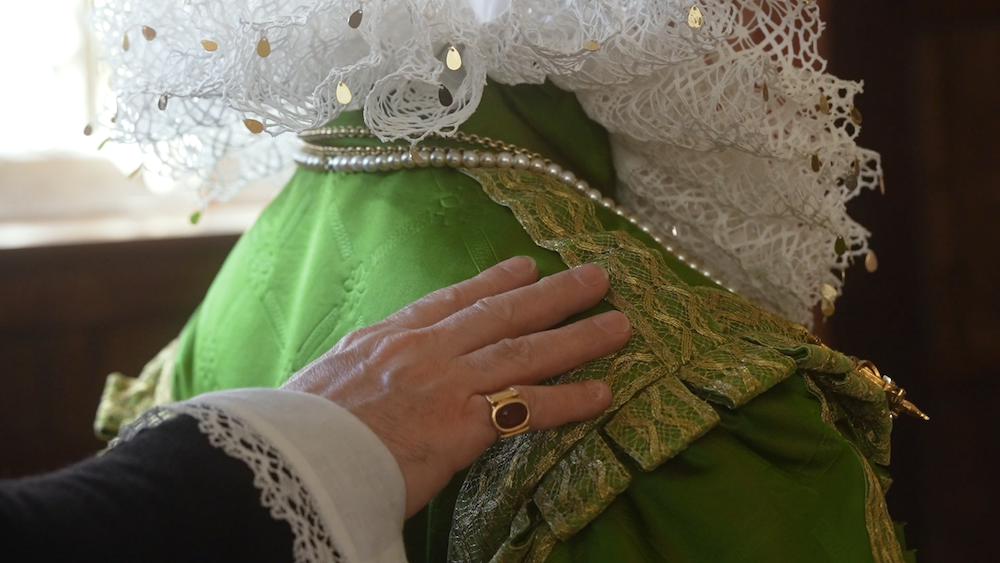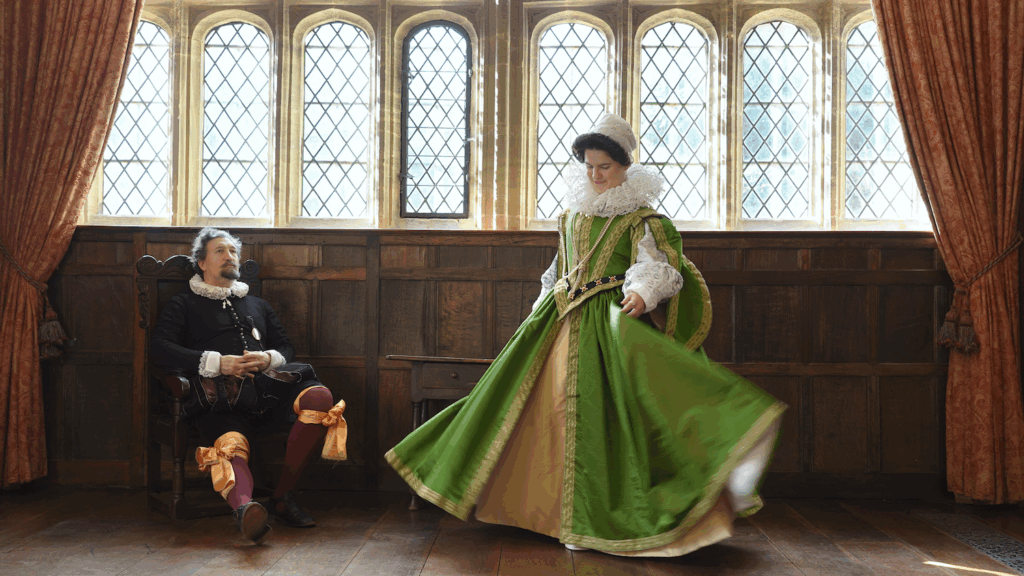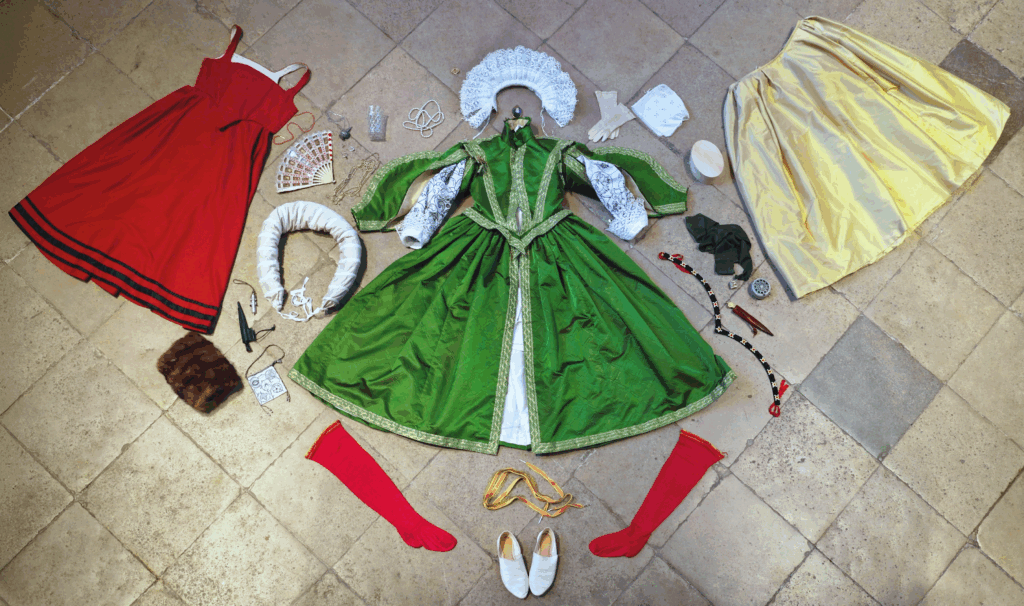
Image © @BernadetteBanner
Athelhampton House, Dorchester, Dorset
The Greensleeves Project is an interdisciplinary collaboration headed by Tamsin Lewis FSA. Tamsin was given a grant by the Society of Antiquaries to reconstruct the clothes described in the famous Elizabethan ballad. The earliest surviving text of Greensleeves dates from 1584 and contains eighteen verses, written in a somewhat obsessive fashion, by a man who showers his would-be beloved with gifts, including many clothes. Put together, these gifts provide us with a rich resource of information on clothing, fabrics, embroidery, and other aspects of material culture. The reconstructed items of dress were made by a team of team of established historians and practitioners each taking responsibility for one or two items.
The conference will be held at Athelhampton House, a beautiful 16th century manor house in Dorset which was also the location for filming of the project. Papers will be presented by Tamsin and many of the makers and the reconstructed garments will be displayed in an exhibition. Refreshments and lunch will be included.
Jump to:
Tickets
Schedule
Paper Abstracts
Travel and Accommodation

Image © @BernadetteBanner
Tickets
£55 Member
£60 Non-Member
£20 Member Video Access
£25 Non-Member Video Access
Complete this form to attend the event in person at Athelhampton House. Be sure to follow the instructions for submitting payment after completing the form; your place cannot be held for you until payment is received. Early Bird member rates are £50. After 1 October, member rates rise to £55. Non-member rates are £60 per person. Due to the size of the room available, places are limited. Registration closes 12 November.
Access to the YouTube video, which will be uploaded after the event, can be purchased here. The cost is £20 for MEDATS members and £25 for non-members. An access code for the discounted price was emailed to members on 4 September. The video should be available and shared with ticketholders by 6 December, 2025.
A full refund will be given if a cancellation is made 30 days or more before the event. Refunds for cancellations made at shorter notice will be given on a discretionary basis dependent on whether the ticket can be resold or not. The final decision will be made by the treasurer.
Schedule
Registration
10:00-10:30
Tea and coffee will be available
Session One
Tamsin Lewis Introducing Greensleeves
Juliet Braidwood with gold embrodered gorgeously – Making Greensleeves’ smock
Sally Pointer stockings all of silk, with golde all wrought aboue the knee (remote presentation)
Mally Ley Garters fringed with the gold
Lunch
Buffet lunch
View the exhibition
Session Two
Eva Burnett Pumps as white as was the milk – Shoes for Greensleeves
Constance McKenzie Petticoats of the best – Making the petticoat with stiffened upper-bodies
Noel Gieleghem A spangled ruff for Greensleeves (remote presentation)
Session Three
Sarah Thursfield Kerchers of the best – Wrought work and headgear
Ninya Mikhaila A gown of grossie green – Making Greensleeves’ gown
Eloise Pennycott Greensleeves was my delight – Embodying Greensleeves
Closing remarks 16:30

Image © @BernadetteBanner
Travel and Accommodation
For assistance arranging transportation or ride sharing to or from a rail station contact Pat Poppy, newsletter@medats.org.uk.
Personal Vehicle
Athelhampton House is brown signed from the A35 (Tolpuddle bypass)
From London: M3, M27 west, A31, then A35 from the roundabout at Bere Regis
From north east: M1, M25 then directions from London
From north west: M5 either come off at Gloucester to Cirencester and then the A350 to Blandford and the A354 to Puddletown, or: continue down the M5 to Taunton and come in via the A358 to Yeovil then the A37 to Dorchester
Public Transit
The nearest rail station is Moreton, which is about five miles away and is on the main Waterloo to Weymouth line.
Next nearest is Dorchester (South), about 6 miles away, also on the Waterloo to Weymouth line. Dorchester (West) is a different station and is on the line that runs from Gloucester via Bristol and Bath to Weymouth.
Most bus routes will require a walk from Puddletown (approximately one mile).
Places to Stay
Hotels in Dorchester are the best bet.
There is a Premier Inn in Brewery Square. This used to be the site of the brewery but is now a regenerated area full of restaurants. There is also an Anytime Fitness in Brewery Square.
The other hotels are mainly on the High Street
There are also a lot of B&Bs.
Abstracts
Tamsin Lewis Introducing Greensleeves
Juliet Braidwood with gold embrodered gorgeously – Making Greensleeves’ smock
The smock is one of the garments given to Greensleeves with more descriptive information than most, but can we really trust it? And, given the dearth of silk smocks in the historical record, how should it be recreated as a real garment? In this presentation, Juliet will go through the research and decision-making process involved in trying to recreate a potentially slightly fantastical garment in such a way that it might be wearable by a “real” historical woman.
Sally Pointer stockings all of silk, with golde all wrought aboue the knee (remote presentation)
Silk stockings reflect a high status and fabulously fashionable gift, with the gold embellishments only adding to the lavishness of the offering. Today, a fully hand knit pair of silk stockings represents an indulgence beyond the budget of most costume projects, so the brief here was to represent this element of Greensleeve’s ensemble using techniques that conveyed the essential aspects of the verse yet remained achievable within the budget and time constraints of the project. This paper explores the thinking behind the choices made and discusses the steps taken to create these luxurious garments.
Mally Ley Garters fringed with the gold
Garters are a necessary, practical accessory and can be as simple as (often mismatched!) pieces of tape. But, given the excess of the other gifts and the two things we are told about Greensleeves’ garters, these needed to be a little more special than that. In this presentation Mally will talk about the decisions and technique used to produce these accessories.
Eva Burnett Pumps as white as was the milk – Shoes for Greensleeves
Constance McKenzie Petticoats of the best – Making the petticoat with stiffened upper-bodies
What is a Petticoat? Lady Greensleeves is gifted two petticoats throughout the song, her “Petticoats of the best (cloth)” and one of “Sendal right.” The petticoat of the best (red wool), which is also the supportive undergarment, is an often unseen but essential garment of the 16th century. Constance will talk about researching what petticoat would Lady Greensleeves wear and how to create a supportive and structured hidden petticoat.
Noel Gieleghem A spangled ruff for Greensleeves (remote presentation)
For some reason, fashions from the ‘80s, no matter the century, seem to share a somewhat over-the-top vibe; ruffs from the 1580s are no exception. As a ruff was not mentioned in the lyrics of Greensleeves, there was no “brief” to follow, a fact equally liberating and terrifying for a creator. We can assume that a woman of Lady Greensleeves’ status would most probably have worn a ruff and cuffs to complete her ensemble, but both the style and set were open to interpretation. Noel will discuss the decisions and methodology used to create what he hoped would be a quintessential ‘80s look to complement, but not pull focus from, the named gifts. In particular, he will discuss metallic spangles and lace and some of the unique challenges presented by both.
Sarah Thursfield Kerchers of the best – Wrought work and headgear
We think of a kerchief as a plain piece of fabric, pinned over a lady’s hair. But in the sixteenth century even the simplest washable linen accessories became fashionably elaborate, and the evidence pointed to a made-up cap or coif like this example in the Victoria and Albert museum collection. There were two challenges to producing a new kerchief for our Greensleeves, and the first was to locate linen and findings of a good enough quality. A raid on a lifetime’s collection of vintage fabrics dealt with that, and the second challenge was to plan a design that was achievable, but sufficiently effective. Fortunately there are enough surviving little linen accessories — coifs, forehead cloths and sleeves — to demonstrate the range of techniques available including cut-and drawn work, pulled stitches and lace insertions as well as surface decoration and to show how a simple design can have plenty of impact. I confess that the blue marking is a modern dodge, but the skill it guided is as old as the needle itself.
Ninya Mikhaila A gown of grossie green – Making Greensleeves’ gown
What would this gown look like? The line in the ballad line gives three pieces of information to go on. The gown was green, it had hanging sleeves, and the sleeves were made of satin. In addition, the ballad was published in 1580, so the style would have been something worn around that date. It doesn’t seem much to go on, but when reconstructing historic dress there is rarely one single source from which all the necessary information can be gleaned and a range of difference sources must be examined for clues to help build the whole picture. In this presentation Ninya will share the research behind the choices made for the Greensleeves gown, as well as insights into the making process.
Eloise Pennycott Greensleeves was my delight – Embodying Greensleeves
A lot is said about Greensleeves, but what does she have to say for herself? How does it feel to be so objectified that you are named only for the clothes that someone else gives you? The lyrics make out that Greensleeves selfishly “would not” love her suitor, but how did she really feel to be burdened with so many gifts? If she was real at all, we can assume Greensleeves may have been little more than a teenager – a young woman at most. Eloise was 19 years old when she wrote the storyboard for the Greensleeves short film, then 20 when it was filmed. In this presentation she will reflect on creating this visual narrative from Greensleeves’ point of view alongside Project Director Tamsin Lewis and Videographer Bernadette Banner, and provide insight into how it really feels to wear all of these astonishing garments.